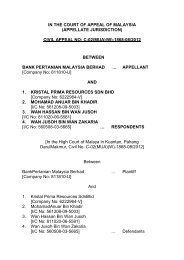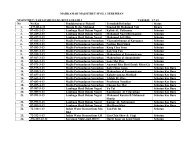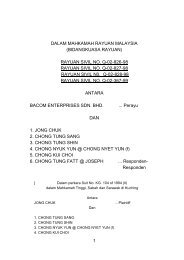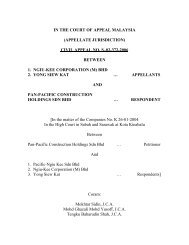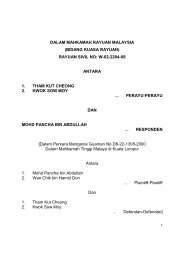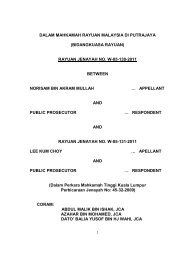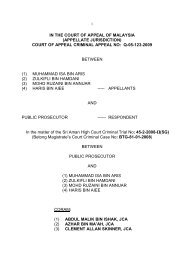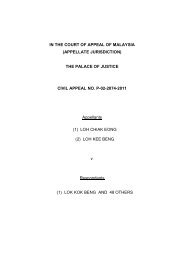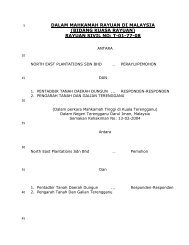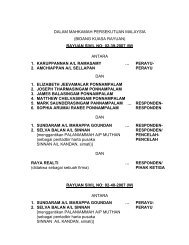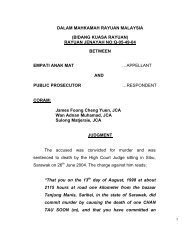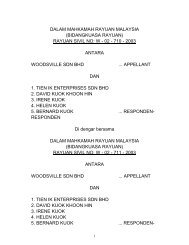DALAM MAHKAMAH RAYUAN MALAYSIA (BIDANG KUASA ...
DALAM MAHKAMAH RAYUAN MALAYSIA (BIDANG KUASA ...
DALAM MAHKAMAH RAYUAN MALAYSIA (BIDANG KUASA ...
Create successful ePaper yourself
Turn your PDF publications into a flip-book with our unique Google optimized e-Paper software.
29<br />
CPC for the government chemist to attend Court as a witness. In<br />
this context, it is ideal to refer to the judgment of Kang Hwee Gee<br />
J (later JCA) in the case of Public Prosecutor v Lam Peng Hoa<br />
& Anor [1996] 3 CLJ 747. There at pages 753 to 754, his<br />
Lordship had this to say:<br />
“The chemist report Exhibit P32 had been served on both the<br />
accused by the investigating officer in compliance with the ten clear<br />
days requirement under s 399 of the Criminal Procedure Code. As<br />
the defence had not given any notice under s 399(1)(b) to require the<br />
attendance of the chemist, the report must therefore be accepted as<br />
conclusive evidence for the prosecution of the finding of the chemist<br />
with respect to the nature of drug recovered and its total weight.<br />
When the learned Deputy Public Prosecutor proposed to call the<br />
same chemist to give evidence, I had to act under s 136 of the<br />
Evidence Act 1950 to require her to state in what manner the<br />
evidence she proposed to elicit from the chemist would be relevant.<br />
On being informed that the chemist would be called to explain the<br />
conduct of her analysis in the drug, I ruled that the chemist if called<br />
would not be allowed to give any evidence in respect of the conduct<br />
of her analysis of the drug, for the following reasons:<br />
(i) The chemist report had already been admitted into evidence. It is<br />
trite law that if a chemist is called as a witness to testify on<br />
matters pertaining to his analysis of the drug, the chemist report<br />
prepared by him would not be admissible, save that it may be<br />
tendered not as a substantive evidence of its contents but as<br />
corroboration of his oral evidence in court under s 157 of the<br />
Evidence Act 1950 (see Saw Thien Teik v. Regina [1953] 19 MLJ<br />
124, followed in Public Prosecutor v Lin Lian Chen [1990] 2 CLJ<br />
1020). Conversely, if the chemist report has been tendered as<br />
substantive evidence under s 399 of the CPC, it follows that no<br />
oral evidence can be given by the chemist in respect of his<br />
analysis of the drug. To allow the chemist to give such evidence<br />
would tantamount to allowing the admission of two sets of<br />
substantive evidence from the same witness which the<br />
prosecution would not have otherwise been entitled to do had<br />
they called the chemist to give oral evidence.<br />
(ii) Section 91 of the Evidence Act 1950 applies.<br />
A chemist report is not per se a ‘matter’ required by law to be in<br />
the form of a document as in the case of a police report under s<br />
107 and a statement under s 112 of the Criminal Procedure Code.<br />
But once the chemist report had been admitted as substantive<br />
evidence under s 399 of the Code it falls squarely into that class



